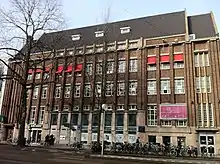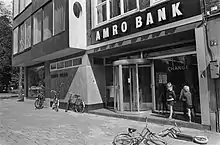AMRO Bank
The AMsterdamsche en ROtterdamsche Bank (AMRO Bank , "Bank of Amsterdam and Rotterdam") was a major Dutch bank that was created in 1964 by the merger of the Amsterdamsche Bank (est. 1871) and the Rotterdamsche Bank (est. 1863). In 1991, it merged with Algemene Bank Nederland (ABN) to form ABN AMRO.
 | |
 Head office of AMRO in southeast Amsterdam, inaugurated in 1987 | |
| Industry | Financial services |
|---|---|
| Founded | 1964 |
| Defunct | 1991 |
| Fate | Merged with ABN |
| Successor | ABN AMRO |
| Headquarters | Amsterdam, Netherlands |
| Products | Asset management Commercial banking Investment banking Private banking Retail banking |
| Parent | ABN AMRO |
Amsterdamsche Bank
The Amsterdamsche Bank was established on 5 December 1871 by a group of mainly German investors led by the Bank für Handel und Industrie (Darmstadt), in the context of German financial expansion following its victory of the Franco-Prussian War. It expanded rapidly from its base in Amsterdam to other cities in the Netherlands. In 1948 it took over Incasso Bank (est. 1891), which it fully absorbed in 1956.
Its elegant art nouveau head office building on Herengracht 597–601, designed by Eduard Cuypers and completed in 1897, was demolished in 1966. A subsequent head office building on Rembrandtplein, designed by Bert Johan Ouëndag and completed in 1932, is a notable art deco landmark of Amsterdam.
 Amsterdamsche Bank head office, ca. 1932
Amsterdamsche Bank head office, ca. 1932 Head office viewed from Rembrandtplein, 1950
Head office viewed from Rembrandtplein, 1950.jpg.webp) The same building in 2017, headquarters of Booking.com
The same building in 2017, headquarters of Booking.com Former Amsterdamsche Bank branch on Sarphatistraat, previously the office of Lippmann, Rosenthal & Co.
Former Amsterdamsche Bank branch on Sarphatistraat, previously the office of Lippmann, Rosenthal & Co.![The adjacent buildings of Twentsche Bank [nl], Netherlands Trading Society and Amsterdamsche Bank on the Blaak [nl] in Rotterdam, 1953](../I/De_Blaak_met_etalages_van_modehuis_Gerzon%252C_en_de_nieuwe_Twentsche_Bank%252C_Nederlandsche_Handel-Maatschappij_en_Amsterdamsche_Bank_1953.jpg.webp) The adjacent buildings of Twentsche Bank, Netherlands Trading Society and Amsterdamsche Bank on the Blaak in Rotterdam, 1953
The adjacent buildings of Twentsche Bank, Netherlands Trading Society and Amsterdamsche Bank on the Blaak in Rotterdam, 1953 Former Amsterdamsche Bank building at Blaak 40, later Kamer van Koophandel Rotterdam, in 2007
Former Amsterdamsche Bank building at Blaak 40, later Kamer van Koophandel Rotterdam, in 2007 Former Incasso Bank building known as De Bisschop, designed by Jan Gratama and built in 1934 at the corner of Dam Square and Damrak in Amsterdam
Former Incasso Bank building known as De Bisschop, designed by Jan Gratama and built in 1934 at the corner of Dam Square and Damrak in Amsterdam Former Incasso Bank building in Rotterdam
Former Incasso Bank building in Rotterdam![Former Incasso Bank building [nl] in Utrecht](../I/514262-Nobelstraat4.JPG.webp) Former Incasso Bank building in Utrecht
Former Incasso Bank building in Utrecht Former Incasso Bank building in Enschede, photographed in 1980
Former Incasso Bank building in Enschede, photographed in 1980 The same building in 2010
The same building in 2010
Rotterdamsche Bank
The Rotterdamsche Bank was established on 16 May 1863 by a group of businessmen and bankers, who took inspiration from the British Colonial Bank and aimed at financing trade and investment in the Dutch East Indies. After a difficult start, however, the bank soon focused on domestic business. Between 1911 and 1947 it was known as the Union Bank of Rotterdam (Dutch: Rotterdamsche Bank Vereeniging of Robaver), following its 1911 acquisition of Rotterdam competitor Deposito- en Administratie Bank (est. 1900) and soon afterwards of Amsterdam brokers Determeijer Weslingh & Zn. (est. 1765). Under the leadership of its ambitious managing director Willem Westerman, it went on to acquire a number of local banks, but became overextended and had to be restructured under the aegis of De Nederlandsche Bank in the mid-1920s. In 1928, it created the Vrouwenbank ("Women's Bank"), a bank targeted at a female customer base that lasted until 1971. In 1960, it acquired Nationale Handelsbank, a major former colonial bank that had been known until 1950 as the Dutch-Indian Trade Bank (Dutch: Nederlandsch-Indische Handelsbank, NIHB; est. 1863).
![Old Rotterdamsche Bank head office on the Boompjes [nl] waterfront thoroughfare, ca. 1905](../I/De_Rotterdamsche_Bank_bij_de_Boompjes_1903_-_1907.jpg.webp) Old Rotterdamsche Bank head office on the Boompjes waterfront thoroughfare, ca. 1905
Old Rotterdamsche Bank head office on the Boompjes waterfront thoroughfare, ca. 1905
 Branch on Rokin in Amsterdam, 1979 (demolished since then)
Branch on Rokin in Amsterdam, 1979 (demolished since then) Former branch building at Kneuterdijk 8, The Hague
Former branch building at Kneuterdijk 8, The Hague![Building at Singel 250 [nl], former NIHB / Nationale Handelsbank headquarters in Amsterdam erected 1910-1912](../I/Sing250.jpg.webp) Building at Singel 250, former NIHB / Nationale Handelsbank headquarters in Amsterdam erected 1910-1912
Building at Singel 250, former NIHB / Nationale Handelsbank headquarters in Amsterdam erected 1910-1912
1964 merger and subsequent history

As early as 1939, there had been plans to merge the two banks but the banks shelved these plans in anticipation of Dutch involvement in World War II. The two banks announced their merger on 11 June 1964, and were integrated during the following year.[1]
As soon as the AMRO Bank was set up, it set about gaining market share in business lending, leasing and factoring as well as in medium to long term credit. To do this it established the Nationale Bank voor Middellang Krediet business unit to provide medium to long term credit. It established or acquired companies such as Mahuko (Society for leasing) and Amstel Lease for its leasing business. The financing of factoring was brought together under the International Factors Nederland B.V., the oldest factoring company in the Netherlands.

In the 1960s and 1970s, like many other banking companies, AMRO saw growth in retail banking and this became a much bigger part of the business. Its wholesale banking was also strengthened by the acquisition of Pierson, Heldring & Pierson (PHP) in 1975. AMRO operated PHP as an independent unit under its existing name. Another acquisition was Utrecht based Bank Flaors & Ko, which had been in existence since 1691. This bank was absorbed under the AMRO Bank brand.
In 1967, AMRO Bank was one of the founders of the consortium bank Banque Européenne de Crédit à Moyen Terme (European bank of long term credit) based in Belgium. The aim was create an entity that was large enough to work at an international level.
Soon after this, with their sights on European integration, AMRO Bank announced plans to collaborate with Belgian Generale Bank with the aim of building a European international bank. However, this project was too ambitious and never managed to get off the ground.[2]
It was only when the Dutch Government announced that it was relaxing its merger rules for financial institutions that ABN and AMRO Bank were able to seize the opportunity to merge and to create a bank large enough to fulfill these ambitions. On 24 August 1990, ABN AMRO was created by the conversion of the shares of both banks into shares of the newly established ABN AMRO Holding N.V.
See also
References
- "ABN AMRO History". ABN AMRO History department. Archived from the original on 6 August 2010. Retrieved 13 July 2010.
- "History of Amsterdam Rotterdam Bank 1964 1991" (PDF). ABN AMRO History department. Archived from the original (PDF) on 1 April 2012. Retrieved 13 July 2010.